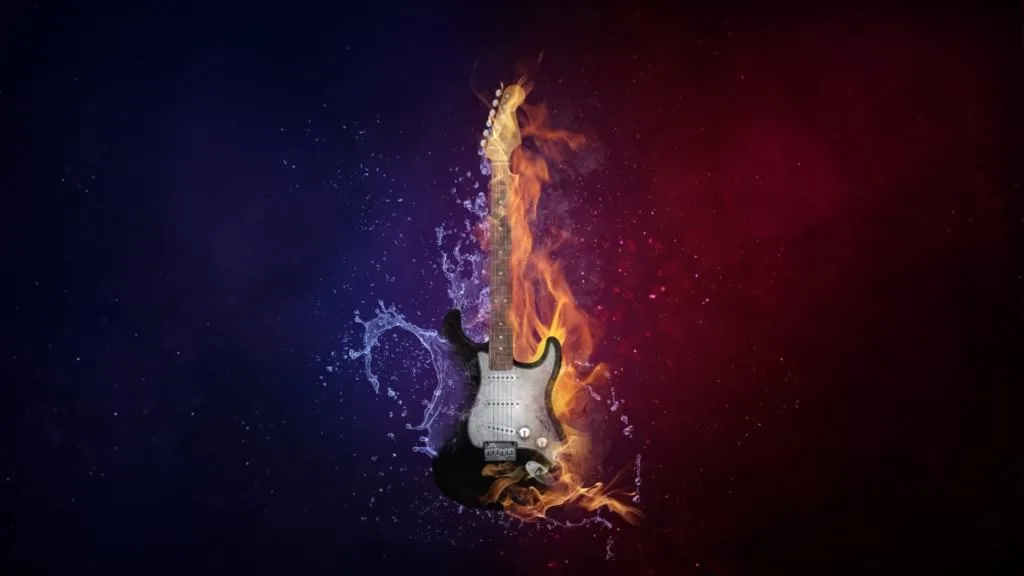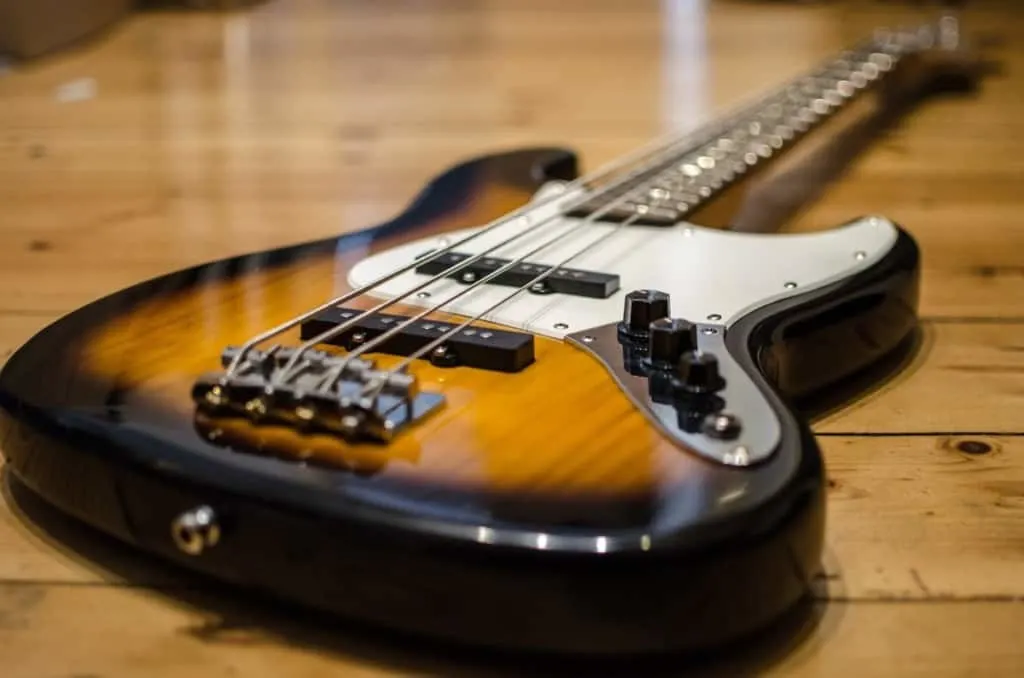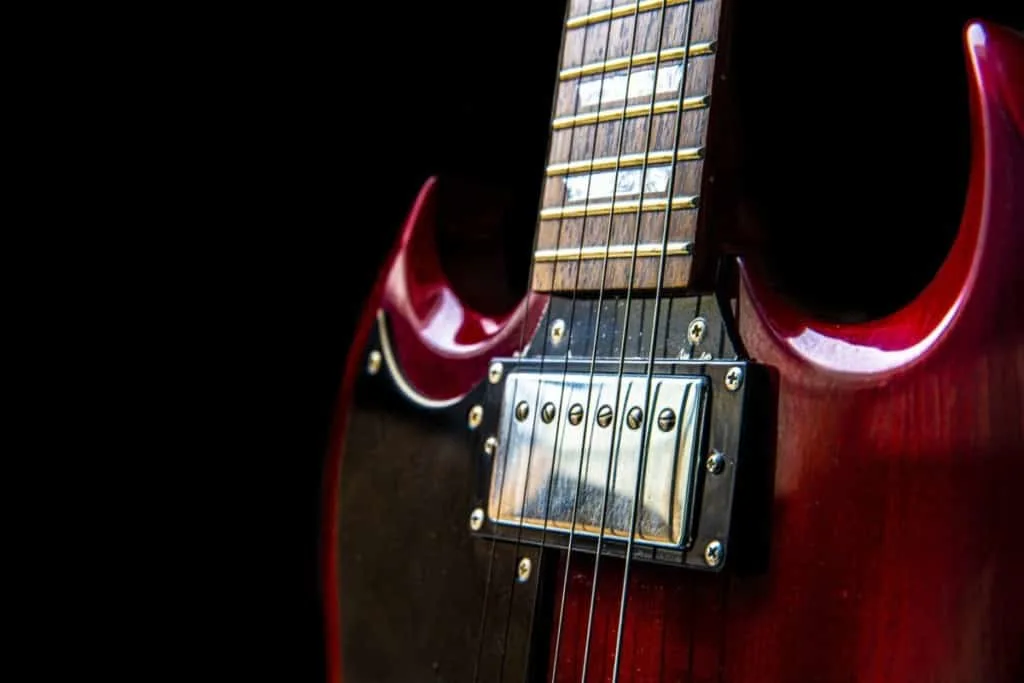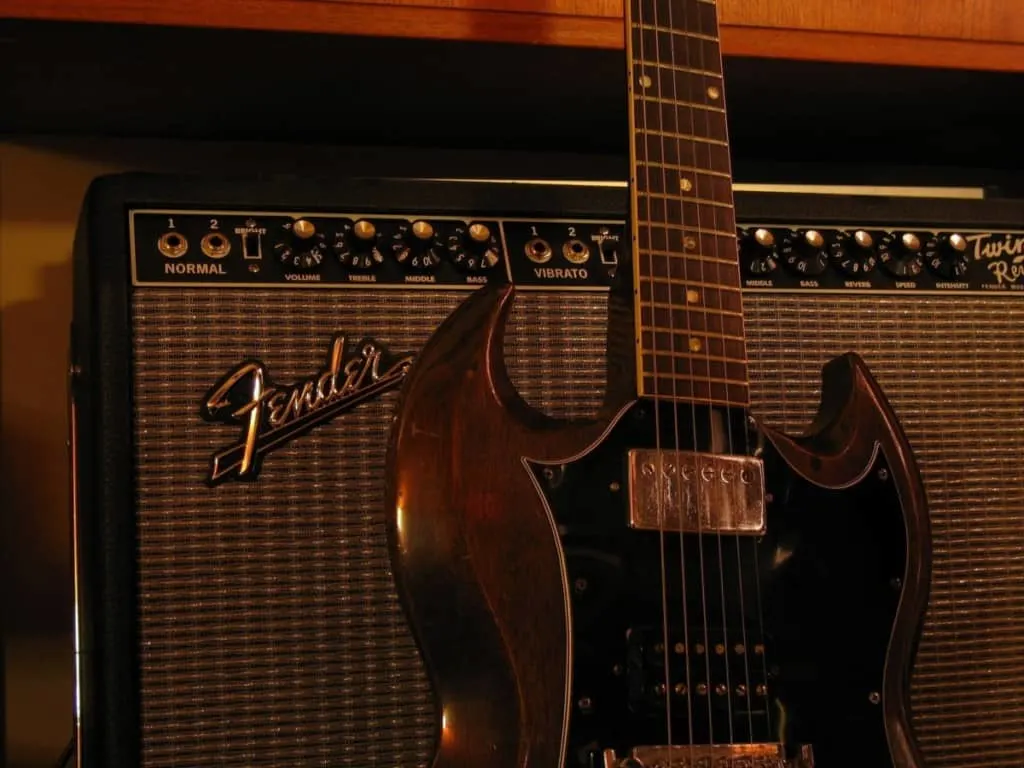Recording a traditional band with bass, guitar, drums, keys, and vocals leaves a lot of room to improvise.
Playing with known standards until we reach new ones is definitely my idea of fun. I’ve been in this business for over three decades and can tell you that I have learned a lot during that time.
I get this question a lot about what to record first and I thought I put this post together so I can answer everyone at the same time.
So, do you record Bass or Guitar first?
You should record drums first with as many people playing at once (recording or not) to give as much feel to the song as possible. If that is not a plausible case scenario either, lay down drums first and then do the rhythm section with guitar and bass or keys and bass. then you can move on to overdubs and the rest.
My other answer is that it also depends on the project. If you are trying to create a super pop tune that is going to be time-perfected in a multi-track with lots of virtual instruments, then everything needs to follow the click and the order is indistinct. On the other hand, if you are trying to capture the vibe and magic of a live band, I suggest you do your best effort to cut the track playing live. If that is an impossible scenario

Don’t get confused just yet, there is a lot of explaining to be done and we’re just about to start. Outside is warm and sunny; I have a cold glass of ice tea in my hands and feel pumped to let all the information flow to the page so strap on a helmet because here we go.
Chasing A Chimera
This is the first thing I necessarily have to address: stop chasing the chimera.
We all have this utopia in our heads that there is a golden book buried at one end of the rainbow with the recipe to the perfect recording; it is time to drop that.
The scary statement I have to make at this starting point is that there is no _right_ or _wrong_.
There is no universal recipe that works with all bands. Not because The Strokes did it and sold millions of records 20 years ago you’re going to achieve the same by repeating their techniques.
What I am trying to say is that once you stop chasing the chimera of perfection or someone else’s success, then (and only then) you’ll start working on making your own thing better.
You’ll start realizing what works for you and your project. Do you have a phenomenal bass player who sticks to the click like glue? How good is he or she in doing the lock-in with the drum kick?
Does your music need that? What about the guitar player? Does he or she lay down amazing rhythm sections that are the heart and soul of your songs or they play atomic riffs?
Is your drummer a self-taught musician or can she or he read music sheets? What about the feel of the song, the moments in your music? Once you know all of that you can make a decision on what to record first
Stop chasing the chimera of perfection; someone else’s dream. Focus on your band, your performance, your recording, and what the feeling is that you want to encapsulate and show the world.
The Traditional Way Of Recording Bass Or Guitar
Ok, so now that you´ve come out of the daydream of being a rock star in Abbey Road with sunglasses, a fake fur coat, and a mammoth hangover, it is time to discuss sonic productions. There is a traditional way of doing things that goes like this:
- DRUMS + BASS + GUITAR + KEYS, OVERDUBS & ARRANGEMENTS + VOCALS
This is a tried and true formula my colleagues and I have been using for a long time.
It didn’t come out of a nutshell in a magical forest, there is a reason behind it. The idea is to track first the spine of the songs and then slowly build the feel and the beauty of it.
Going from the bones to the flesh is something that works great in certain case scenarios but not in every scenario.

Pros Of Recording Bass Before Guitar
You can make sure that the spine of the song works perfectly before putting anything on top of it.
For example, those rhythm sections which need to be perfectly in sync to generate a determinate groove feeling benefit a lot from building it as a block before anything else.
Believe me, when you are on the other side and hear something that works in that sense, you instantly respond physically to it. Another pro is that you can pay a lot of attention to each part separately which ends up being a great way to dissect each section and correct even the tiniest thing you want to correct.
I have written an article that discusses the difference between guitar and bass amps. You can read it here.
Cons Of Recording Bass Before Guitar
The biggest con of this approach, in my opinion, is simply that it can kill the feel of a song. Most musicians can go the extra mile in the studio when the settings are adequate.
There is an extra 10% that especially drummers can give to certain parts of songs that are amazing to capture in a recording.
With this approach, you’ll have the drummer playing to a line of rhythm guitar and bass that will very likely be replaced afterward and the singer doing no effort just humming melodies and notes. That is not the perfect setting to record the most soulful drums in history, is it?
Old School Restrictions Vs New School Freedom
Back when bass, guitars, drums, and everything else went into tape there was no room for correcting a faulty take afterward.
In fact, at the very beginning, everything was recorded straight through a unique microphone. The restrictions of old school equipment can take you to a very interesting territory.
In fact, some nuances and small “mistakes” give old recordings a lot of its character. Some people find that recording in a single take with the entire band straight to tape or a DAW opens up a door that can push creativity further.
It wasn’t until The Beatles came along and starting going further with instrumental experimentation that overdubs became a common thing. Songs like Tomorrow never knows that had backward instruments and more textures became impossible in a single take.
Nowadays, we have infinite freedom.
At home with an audio interface, a microphone, and a computer you can record as many tracks and takes and songs as you like.
This can be a huge leap forward in terms of creativity or can work as an energy-drainer. Sometimes musicians get lost in the infinite amount of available options and their energy is deviated from the creative process to the technical side and it can be a really bad move.
In terms of guitar, bass, keys, drums, and vocals and what to record first new-school freedom allows you to improve that performance afterward and quantize the drums to make it sound perfect, for example.
This is a great trick for pop songs that incorporate different machine-generated sounds. On the other hand, quantizing a drummer that plays with feel and soul is killing the take and for those case scenarios old-school restrictions work better and you should record drums and bass together if you have the chance.
The good news is that both schools of recording coexist today and it is a matter of choosing.
Don’t just take my word for it; just watch Dave Grohl explain it in front of a camera.
Here’s a tour of his studio too.
Finally, a perfect example of old-school commitment is Jack White’s American Epic documentary.
Hey! But What About Recording Riffs?
Ok, now we are getting into a difficult terrain: what about songs revolting around guitar riffs?
Well, if you know a little about modern music you know what a guitar riff is.
When the guitar riff is powerful enough (think AC-DC, Led Zeppelin, Lenny Kravitz) the whole song is created around it. If that is the case you can’t ask everyone else to play their part without the almighty riff sounding loud and clear. Moreover, the bass, guitar, and drums should be perfectly locked in to create the groove around the riff.
Failing to do this will immediately turn a scorcher into a stale attempt.
Believe me, I’ve seen the scenario I´m about to describe happening a million times. Let’s say the guitar player has an amazing riff and the whole song is around it. They’ve rehearsed it until exhaustion and are ready to record it.
Once you have the bass and drums recorded with the reference guitar you replace it with the definitive one.
The guitarist is going through the riff and suddenly realizes that there are note discrepancies between the guitar and the bass. The bass player always thought the guitar player was playing a note he is actually not. So, what do you do? You go back to zero and record bass and even maybe drums differently or just change the guitar part?
Can you imagine a song like Rock and roll by Led Zeppelin with a different guitar riff? I know me neither. So, the bottom line is that when the riff is king you have to respect its ruling and follow: record drums and guitar.

Rock n Roll Knows No Rules, Create That Atmosphere
Rock n Roll is more than just a music style; it is an attitude.
If you truly want to capture the feeling and the groove of rock n roll in the making, the question is not what to record first but what does the song need. Rock n roll knows no limits and knows no rules.
As a musician, I am always worried about playing the right notes until I know the part so well it is part of my flesh and bone. Then (and only then) I know I am ready to put it down on the track and can even drop some extra magic during the take.
It is an amazing feeling when you’re cruising through the tune, enjoying the rest of the instruments playing. My fellow bandmates think the same way as I do and together we rehearse obsessively before getting into the studio.
On the other side of the window, as a producer and engineer, I am aware of the feel of the tune and the band.
I try emphasizing to the musicians that there is up to 25% of the result that depends on the feel and the momentum they are able to generate. There is no digital replacement for a soulful performance yet.
You can dissect it as much as you want, but you can never get to it; it is ethereal. In order to capture that 25% of the recording, you need to provide the right atmosphere in which rules do not apply.
Walk away from terms like “right” and “wrong”. Doing things the wrong way usually brings you to a new sonic territory. Be comfortable with bending and breaking even your rules. Remember, rock n roll knows none of those and suffers from them; don’t make the band fit your rules, reinvent yourself to make the most out of their performance.
Ask (the right) Questions When Recording Bass And Guitar With A Band
Coming from the last item, it is important as a musician, producer, and engineer to ask the right questions; in fact, it is important to ask a lot of questions.
What I do when a band comes to my studio is to ask if I can invite them to rehearse in the live room before recording. We set up everything before the first day and I have them go through all of the songs together with a PA and all and I capture it with a microphone to create a stereo mix.
With that material in my hands, I already know how to work with them; what to emphasize, who is more nervous than who, and, most importantly, how to help them be their best version.
Personalized Monitoring Mixes Save The Day
- I can’t stress this enough: ask the musicians what they want! Very simple questions that save my day time and again are “who do you follow when you’re playing?” and “What do you need in your monitors?”
The first question allows me to set up the reference players for the song.
Let’s say the drummer follows the keyboard player on a song, a guitar riff on another, and a phat groovy beat with the bass for another. Write that down and make it a priority; same thing with bass, guitars, and all the rest. Personalize musician’s monitoring mixings and they’ll be forever thankful.
Try These Case Scenarios For Recording Bass And Guitar
Now that you know the different variables let’s go through some case scenarios and what to record first if drums, bass, guitar, keys, or vocals.
Let the singer rest
This is an approach I learned recently and found that changes the vibe completely. Having a marathon day for singers to cover all the songs and backing vocals can be great for the first two or three tracks and annoying for the rest. I always leave a couple of hours at the end of every session day for vocals. This way the singer(s) can have time to look back on their performance and do adjustments. Also, they can rest and at the same time be active and participative on a daily basis.
Pre-production on a multi-track
This is my favorite way to record a band.
Whenever they come to the studio to see me I urge them to do multi-track pre-production in which they dissect every part including vocals and then go into the studio knowing exactly how to do it.
This helps with nervousness and allows everyone to play over a finished song retaining that “live” vibe. Here is an example of how Foo Fighters work replacing everything but the drums after the initial band recording.
The Click Is King
This is a decision that musicians have to make when in the studio.
One approach would be to have the drummer play to the click and then remove it to give it a more organic feel for the rest of the musicians. Another is to have everyone play to the same click and let the click be king.
This works especially well when you have written music and great schooled musicians. Everybody playing to the click and reading their notes can make a perfect take regardless of the order in which they record.
Speed Limits
It is not uncommon that drummers (and entire bands) speed up and down in the middle of a song.
This is completely normal, it is directly related to the fact that they are excited about what they are playing!
If it is a bad thing for the band who don’t want it in their music, then a click can help you set some speed limits and you should definitely record drums and the entire rhythm section at once.

The Key Role Of Vocals For A More Organic feel
As a piece of final advice on what to record first, I would say that vocals are always welcome because they give the feel to the music.
Even words can be key for a musician in terms of how to execute his or her instrument. I use singers a lot in the studio; they sing everyday plenty of times a day.
For example, doing keys and guitar overdubs without vocals is very dangerous because both sit on similar frequencies. If the keyboardist or guitarist plays too much it might cloud the bright shining of the vocals, and the song can end up being too cluttered and the melody lost.
Push the vocalists to do their thing all the time. If a band is a four-piece I would say that they handle 60% of the track and vocals alone are the remaining 40%. In fact, what most casual listeners, people out of the business registers and sticks to their brain are melody and words; don’t leave those for the last day.
Final Words On Recording Bass Or Guitar First
A recording is an art form: the art of capturing energy into sound waves. With time and practice, you’ll understand where the energy source is in each band and what to do to emphasize it.
Recording drums first is always a must unless everything is written and click is king.
After the drums are done you have to build the song on top of it. Instead of asking myself what to record first if bass, guitar, keys, or vocals I ask myself how many things can I record at once and then replace? Sometimes it is just the drummer inside the live room and everybody going at it from the control room with nothing but direct boxes.
Until you have gone through several musical styles I suggest you try to set up your studio to make live takes as much as possible and replace them afterward.
Feel free to check out my article on the best 21 guitar accessories. You can read it here.
Never forget that you are capturing something, not creating something. Make musicians feel as comfortable as to pour onto the instrument their soul and feel forgetting about machines ticking. Concentrate on capturing epic moments and they will surely last forever.
Happy (soulful) recording!
